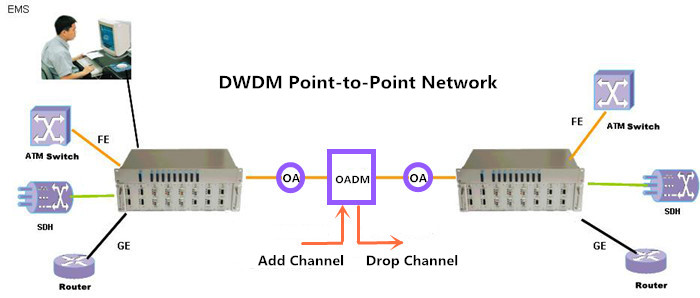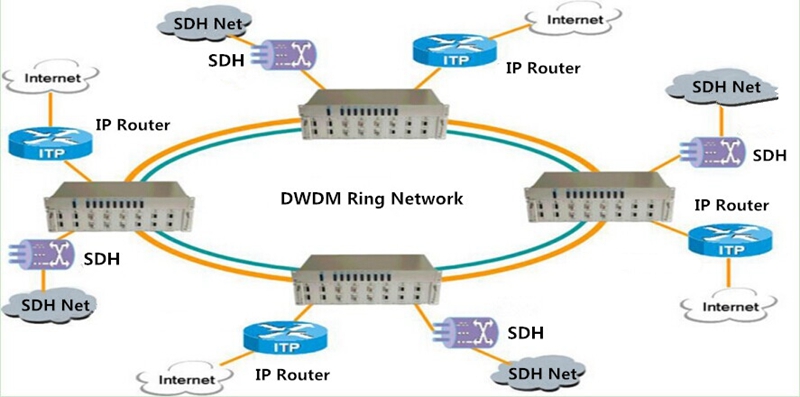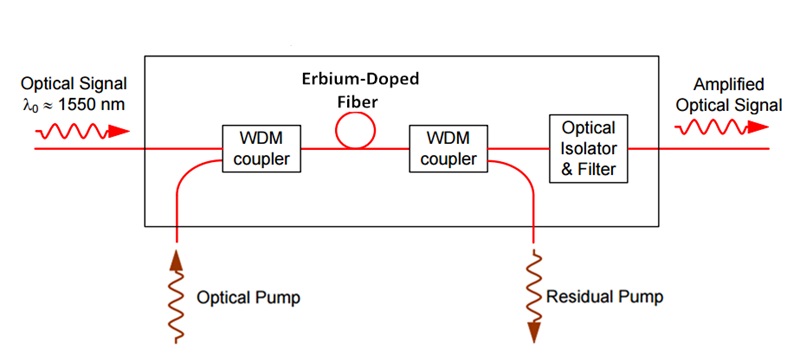Why Not Using DWDM Technology to Build Your Network?
četvrtak , 08.06.2017.Currently, more and more users choose to deploy DWDM networks on the basis of their existing networks, as the normal network can’t afford enough capacity for their daily use. Considering that there may be some confusion for designing the DWDM networks, this paper will mainly introduce the basic knowledge of DWDM technology and analyze the difference between SDH and DWDM technology. To better understand the DWDM technology, this paper will also guide users to deploy two common kinds of DWDM network. Hope the DWDM information in the paper would be useful for deploying a smooth DWDM network with higher transmission rate and capacity.
Introduction to DWDM Technology
DWDM technology is an ideal solution to address the capacity-hungry issue, which can multiplex several wavelengths for transmission different kinds of signals through one single fiber. In principle, the network utilizing DWDM technology enables carry up to 140 channels for transmitting signals, finally achieving high bandwidth transmission. As for the DWDM components, it basically includes DWDM multi-channel Mux/Demux, dispersion compensation module, fiber optic amplifier, optical transponder, and so on.
SDH vs DWDM Technology
As we know, SDH is the technology combining more than one lower-speed electrical or optical signals into a single higher bit rate signal with a single wavelength for transmission over a single fiber or wire. In the network utilizing SDH technology, Time division multiplexing (TDM) or statistical TDM is used, which means the signals in SDH network will be received by distributed across time slots. As for the DWDM technology, it uses wavelength multiplexing method, so that the signals can arrive at the receiver simultaneously. In the DWDM network, the DWDM multi-channel Mux/Demux mentioned above is the key components that can give different wavelengths to the different optical signals and multiplex them, so that the integrate signal with different wavelengths can be transmitted over a single fiber.
In short, SDH uses time division multiplexing, while DWDM works with wavelength division multiplexing. Compared to the SDH technology, DWDM can give different wavelengths to the optical signals, which allows the signals to be transmitted with their own speed and protocol and arrive at the same time. Besides, the SDH network can transmit both electrical or optical signals, while DWDM network only supports optical signal transmission.
Common DWDM Network Designs
Generally speaking, there are many kinds of DWDM networks with topological configurations, each of them has different requirements and can be used for different applications. They are basically DWDM point-to-point network, fully connected mesh network, star network, ring network and hybrid DWDM network consisting of stars and/or rings that are interconnected with point-to-point links. The following will mainly introduce the two most common DWDM networks, point-to-point network and ring network for your reference.
DWDM Point-to-Point Network: this kind of DWDM network is always deployed for long distance transmission with fast transmission speed, high bandwidth, great reliability and path restoration capability. The numbers of fiber optic amplifier used in this DWDM network is often less than 10, while the transmission distance can be up to several hundred kilometers. If optical add-drop multiplexer (OADM) is used, channels can be dropped or added along the path of the DWDM link. To better know the DWDM point-to-point network, here offers a figure that shows a DWDM point-to-point network design with the use of DWDM multi-channel Mux/Demux, OADM and fiber optic amplifier.
DWDM Ring Network: In general, this kind of DWDM network is often applied in local or metropolitan areas that can support the DWDM network at lengths up to dozens of kilometers. A basic DWDM ring network is shown in the following figure that has many nodes fully interconnected by the fiber, and sometime there are two fiber rings in a DWDM ring network which are deployed for protecting the network. Besides, the DWDM components like DWDM multi-channel Mux/Demux, OADM and optical amplifier are also required in the DWDM ring network.
Conclusion
DWDM technology is an economical solution for transmitting multiple signals through one fiber, which can solve the problem of insufficient capacity in your network. In contrast with SDH technology, DWDM technology enables the optical signals to be transmitted fast and arrive at the receivers simultaneous, while offering much higher capacity and transmission rate. If you are interested in DWDM technology, you can visit FS.COM where the DWDM Mux Demux, OADM and optical amplifier are available. It is recommended because of the good DWDM Mux Demux, OADM and optical amplifier price and quality.
Oznake: DWDM Mux Demux, fiber optic amplifier
komentiraj (0) * ispiši * #
Why Not Use EDFA Amplifier in Long CATV Network?
petak , 19.05.2017.When deploying a long-distance CATV network, we always worry about the link performance due to the fiber attenuation that may make the CATV signals weaker and weaker as the distance of the CATV link increases. How to deal with it? Here offers the EDFA amplifier as an ideal solution that utilizes both laser and fiber technology to amplify signals. By using the EDFA amplifier in CATV application, the low CATV signal power can be enhanced into CATV high signal power for a long-distance CATV network link. To better know the EDFA amplifier function for CATV network, let’s study the basic knowledge of EDFA amplifier and analyze a typical CATV network using EDFA amplifier.
EDFA Amplifier Overview
EDFA is an fiber optic amplifier cleverly bonding laser technology and fiber technology to enhance the signal power, which can be used for extending the CATV network. Hence, EDFA used in CATV application can be also called CATV EDFA amplifier. Basically, the CATV EDFA amplifier has two kinds of configurations, co-propagating and counter-propagating configurations, designed with different working principles.
As for the EDFA amplifier with co-propagating configuration, you can learn it from the following figure. When the optical signal with wavelength around 1550 nm comes into the EDFA amplifier, it will firstly combine with the optical pump offered by the EDFA amplifier. Then the optical signal and pump will pass through a WDM coupler, be multiplexed into the erbium-doped fiber. Thirdly, the optical signal will be amplified and the residual pump will be removed from the fiber by the second WDM coupler. An in-line optical filter to prevent the pump light from outputting with the amplified signals and an optical isolator to prevent the reflected light from entering the amplifier will be placed after the second WDM coupler. Thereby, the signal amplification can be finally finished.
As for the EDFA amplifier with counter-propagating configuration, the optical pump would firstly pass through the second WDM coupler, then multiplex with the optical signals into the erbium-doped fiber, and finally be removed from the fiber by the first WDM coupler. Compared to the co-propagating one, it will produce more noise but higher output power. Hence, combining the co- and counter-propagating amplification with bi-directional configurations to compromise is highly recommended. For more EDFA amplifier information, you can learn from EDFA wiki.
What Can CATV Network Benefit from EDFA Amplifier?
Compared to the traditional PDFA amplifier, EDFA amplifier performs better in CATV network due to its superior characteristics like low noise figure and low loss. As for the detailed characteristics of CATV EDFA amplifier, we can learn them as below:
It has a relatively low noise figure and high stability.
Its RS232 interface is very user friendly which is easy to control and monitor.
It works at 1550nm, consistent with C-band. Thereby, the fiber loss can be highly reduced, which enables a longer CATV network.
It features a wide signal gain spectrum, up to 30 nm or more. Hence, it is a good choice for broadband signal amplification, especially in WDM network.
It designed with higher saturation output power for better performance in CATV network longer than 100 km. Besides, this feature also benefits complicated network that requires splitting optical signals into multiple fiber optic receivers.
Analysis of a Typical CATV Network with EDFA Amplifier
Here offers a figure about a basic CATV network that uses the CATV EDFA amplifier to enhance the signals with 1550 nm for a longer transmission distance. We can see at the Local CATV Provider side, multiple signals are sent and then processed and combined into an integrated CATV signal with 1550 nm. Then CATV EDFA amplifier are used for amplifying the signals, thereby the transmission distance can be extended from 50 km to 150 km. With the use of CATV EDFA amplifier, these signals can be amplified, transmitted longer and finally split into multiple signals with 1550 nm again to server the hotel rooms.
Conclusion
EDFA amplifier can serve CATV applications well because of its high output power, but low distortion and noise capability. It is an idea solution to enhance signals for extending CATV network transmission distance, especially in the long CATV network, more than 100 km. It is also useful in the CATV network where the optical signals should be finally split into multiple fiber optic receivers.
Oznake: EDFA amplifier, fiber optic amplifier
komentiraj (0) * ispiši * #




